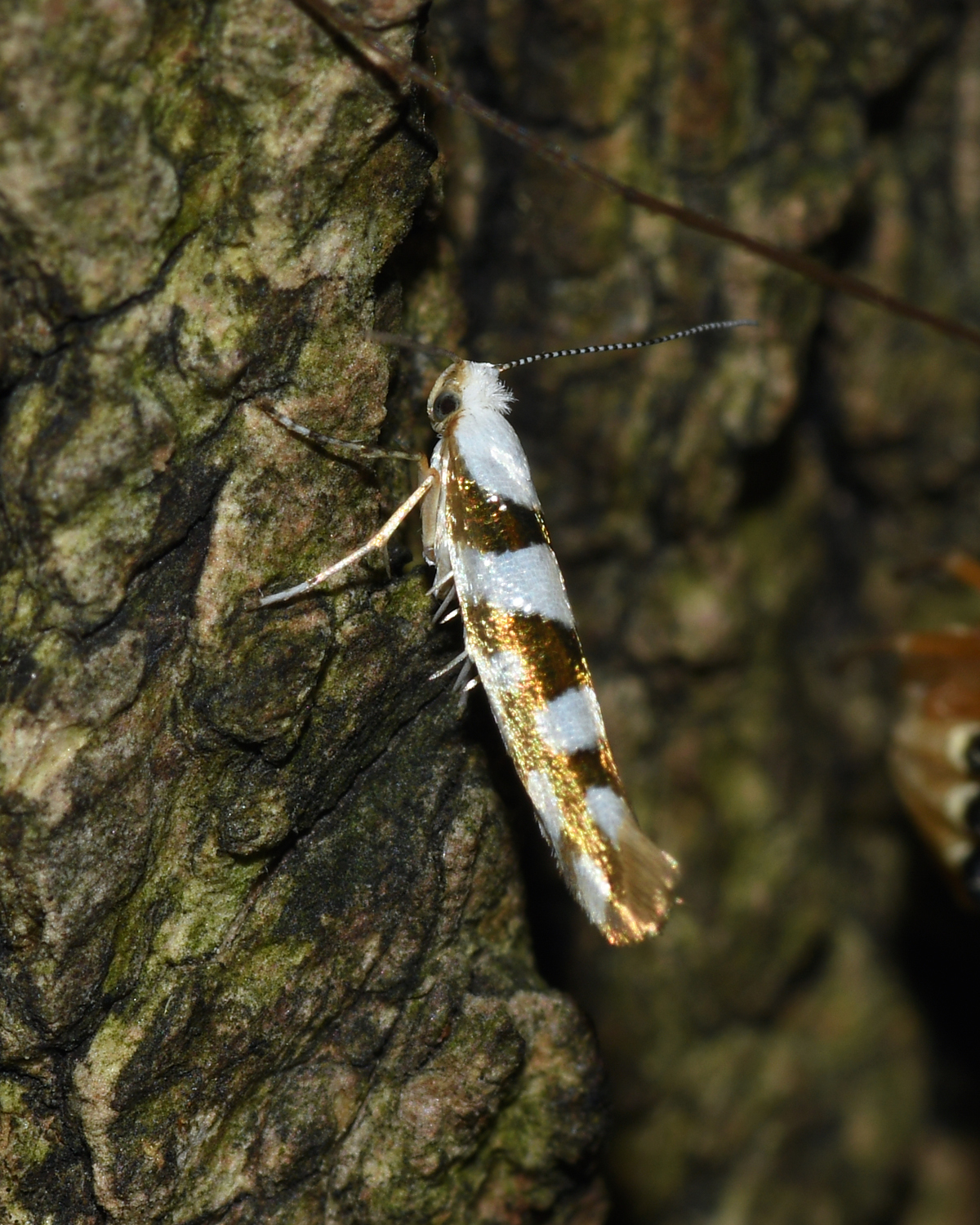Notes on Argyresthia goedartella (Linnaeus 1758) vs. A. calliphanes Meyrick 1913
In his original description, Meyrick (1913) characterized Argyresthia calliphanes as having a white thorax and A. goedartella as having a golden thorax.
Forbes (1923), in his Lepidoptera of New York Series, seconds Meyrick's notes on distinguishing the two species saying of Argyresthia calliphanes: "Head white, thorax white, wing markings exactly like those of A. goedartella", and of A. goedartella: "thorax bright golden, fore wing white and coppery golden". He also states the range for A. goedartella to be "Europe; reported from some places in the United States, in part, at least, in error for A. calliphanes". This was also supported in Covell (1984).
Furthermore, volume 12 of the World Catalog of Insects series Lepidoptera: Yponomeutoidea I (Argyresthiidae, Attevidae, Praydidae, Scythropiidae, and Yponomeutidae) by Jon Lewis and Jae-Cheon Sohn (2015) also notes: “This species has been confused with A. goedartella L. It is still unclear if both A. calliphanes and A. goedartella are present in North America. Therefore, some Nearctic records of A. goedartella may be due to confusion with A. calliphanes. A careful revision of these records is necessary.”
This is additionally corroborated by Pohl et al. (2018) in the Annotated Checklist of the Moths and Butterflies (Lepidoptera) of Canada and Alaska, which states the following about Argyresthia calliphanes: "The identity of this species has long been confused with A. goedartella. Forbes (1923) claims that most North American reports of the latter actually refer to A. calliphanes. Until this matter is resolved, we list only the type locality (ON: Toronto) as a valid A. calliphanes record, and all other material is treated as A. goedartella.". They also have an additional note under A. goedartella: "According to Forbes (1923) and Covell (1984), this species is not widely distributed in North America, and most reports of it actually refer to A. calliphanes; see note above under the latter.".
I am of the view that with the distinctions made by Meyrick (1913) and Forbes (1923) as well as the knowledge that the type locality of A. goedartella is in Europe, and the type locality of A. calliphanes is in Eastern North America, it would be more prudent to refer to all Eastern North American individuals resembling Argyresthia goedartella/A. calliphanes be referred to as A. calliphanes until demonstrated otherwise.
I’ve also browsed images of Argyresthia labeled as A. goedartella throughout North America and none, save for a few images from Alaska, have clearly gold thoraces (see here). Others appearing with gold thoraces elsewhere in North America appear to actually show the cuticle of the exoskeleton due to wear. It’s interesting the gold thoraces are found in Alaska which is very close to the eastern fringe of the Palearctic, and may represent some form of a Beringia scenario.
Lastly, I examined BINs on BOLD of species labeled as Argyresthia goedartella but with white thoraces and compared these with those with gold thoraces. While things mostly were sorting based on thorax color, there seemed to be some separate BINs of those with white thoraces, which may suggest some cryptism in the species with white thoraces, particularly in the Pacific Northwest and the Southwest. This trend was also observed by the limited amount of phylogenetic work I have done on the genus based on a single gene (cytochrome oxidase subunit I, COI). There definitely needs to be extensive sampling in Alaska, the PNW, and the SW that compares specimens from these locations to European and Eastern North American representatives to fully resolve this issue but these are my current thoughts.
Here is an observation by user pmali under Creative Commons CC-BY-NC-SA showing what the European Argyresthia goedartella looks like with the gold thorax:

Here is an observation by user josh_vandermeulen under Creative Commons CC-BY-NC-ND showing what I think has been often misidentified as Argyresthia goedartella but is instead Arygresthia calliphanes, with the white thorax:

I will update this journal post by posting comments below with any future updates in the literature as well as any additional insights that I have. Any edits to the text here will just be for clarity/typo-fixing. I investigated this dilemma as a component of my undergraduate research on Argyresthia with @jasondombroskie.
Update 31 March 2023: we have published this reasoning in SHILAP Revista de lepidopterología (Gorneau et al. 2023).
References
Covell Jr., C.V. 1984. A field guide to the moths of eastern North America. Houghton Mifflin
Co..
Gorneau, J. A., Jones, L. D., Monzón-Sierra, J., & Dombroskie, J. J. (2023). Three new species of the genus Argyresthia Hübner, [1825] from Guatemala, with notes on host plant evolution and Nearctic taxa (Lepidoptera: Argyresthiidae). SHILAP Revista De lepidopterología, 51(201), 159–181. https://doi.org/10.57065/shilap.444
Lewis, J., Sohn, J.-C., 2015. Lepidoptera: Yponomeutoidea I (Argyresthiidae, Attevidae,
Praydidae, Scythropiidae, and Yponomeutidae). World Catalogue of Insects Volume 12. BRILL.
Linnaeus, 1758; Syst. Nat. (Edn 10) 1: 541
Meyrick, E. 1912–1916. Exotic Microlepidoptera. Vol. 1. Thornhanger, Marlborough, Wilts,
640.
Pohl, G.R., Landry, J.F., Schmidt, B.C., Lafontaine, J.D., Troubridge, J.T., Macaulay, A.D., van
Nieukerken, E.J., DeWaard, J.R., Dombroskie, J.J., Klymko, J. and Nazari, V. 2018. Annotated checklist of the moths and butterflies (Lepidoptera) of Canada and Alaska.






